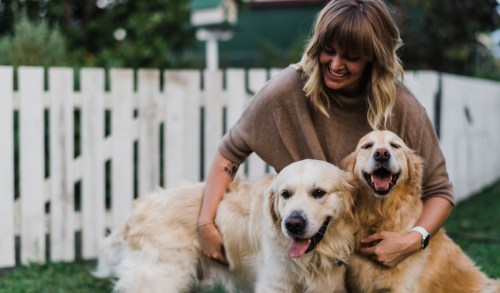If pet owners could spend every waking moment with their dogs, most would take it. But between work and social obligations, many people often end up having to leave their dogs unattended for long periods. While there’s no substitute for quality time spent with your pup, dog daycare has offered a solution for busy owners that want to keep their canines happy, physically active, and mentally stimulated while at work or away. And the peace of mind that can bring is priceless.
Experts in This Article
What is dog daycare?
Dog daycare often refers to a program or facility providing care for dogs outside their homes. In other words, it’s the canine equivalent of daycare for kids. Not to be mistaken for a dog boarding facility, which offers long-time care for several days or weeks, doggy daycare often provides short-term care for a half or full day of fun.
Dog daycare prices
The dog daycare prices can vary depending on the program or facility and its offerings and where you live. According to CostHelper, doggy daycare can cost $6 to $38 for a half-or full-day, or $240 to $550 for monthly rates, with prices increasing by as much as 30 percent in large cities. What’s more, all these prices are exclusive of additional costs, such as application fees, pickup and drop-off services, and emergency veterinary treatments in the event of an accident. Suffice it to say: Doggy daycare doesn’t come cheap, perhaps because these costs will typically include amenities and their upkeep, plus expenses for food, water, toys, and on-the-ground staff members.
Doggy daycare isn’t necessary, but if you have the option, it can be a real treat for you and your dog—especially when run well. If selected wisely, it can offer dogs myriad benefits that will positively impact their overall well-being.
The benefits of dog daycare
1. It’s an opportunity for socialization
“Doggy daycare helps dogs to develop their social skills,” according to veterinarian and animal behaviorist Paola Cuevas, DMV offering an opportunity for dogs to interact with other dogs and people, which is incredibly important to a dog’s well-being.
2. It provides your dog with physical and mental stimulation
In addition to socialization, veterinarian Chyrle Bonk, DMV, says that doggy daycare also provides your dog with the physical and mental stimulation they need to be happy. Many facilities allow dogs the freedom to run and play and offer activities or toys to keep them engaged and entertained.
3. It staves off destructive behaviors
Because doggy daycare facilities provide a healthy outlet for dogs to expel their energy, it can, in turn, help stave off destructive behaviors that often come from boredom. Think: Excessive barking, chewing, or digging.
The potential downsides of dog daycare
While there are myriad benefits to sending your dog to daycare, it’s also important to mention its potential downsides. For one, Dr. Bonk says there’s a risk of transmitting opportunistic illnesses from dog to dog, much like in a daycare facility for kids. She also says that leaving a dog in the care of others can potentially make pet owners worry that their dogs aren’t being treated the way they should be. It’s why Dr. Bonk and Dr. Cuevas stress the importance of selecting a dog daycare facility run well and by people who know what they’re doing.
What to look for when selecting a dog daycare
If you’re searching for a daycare for your dog, it’s essential to find a program or facility that makes your dog’s well-being an utmost priority, but with so many options, the search isn’t without difficulty.
1. A rigorous application procedure
To start, you might opt for a doggy daycare that requires dogs to be fully vaccinated, dewormed, and cleared by a veterinarian before joining the daycare. “This helps to minimize the risk of spreading or contracting infectious diseases,” says Dr. Cuevas. She also says it’s worth inquiring about which vaccines are required for dogs to attend daycare. At the very least, they should mandate core vaccines, including for canine parvovirus, canine distemper virus (CDV), canine hepatitis, and rabies—and if they require non-core vaccines, she says that’s even better.
2. A professionally trained staff
Dr. Cuevas recommends asking whether veterinarians are on staff or veterinary consultants at the dog daycare. “This usually results in higher hygienic standards and the implementation of biological control and prevention methods,” she says. She also mentions that it’s crucial to ask about the qualifications of the caretakers and staff, who ideally should have behavioral management training, so they know how to properly socialize dogs and prevent aggressive or displacement behaviors (which often occurs when a dog is anxious or stressed).
3. A clean and safe environment
You’ll also want to ensure that the environment is clean. “Look at the facility’s cleanliness, including the smell,” says Dr. Bonk. She adds that you might also want to ask how often the staff cleans and disinfects the common areas, toys, and food and water bowls. As importantly, you want the daycare to be a safe space for your pup. “Make sure it has secure fencing and safe toys,” Dr. Bonk says. Be on the lookout for toys made with parts that your dogs might choke on or ingest—and ensure that staff members supervise your dog while they play.
4. A well-balanced schedule
Many daycares for dogs will lead canines through a schedule, typically involving bouts of play and enrichment activities to keep them happily preoccupied. While all well and good, Dr. Bonk says, a program must include rest, with ready access to fluids and food. According to Dr. Bonk, “you’ll want to make sure there is enough playtime for your dog to socialize and get some exercise, but having some downtime is also important.” In other words, a doggy daycare that maintains a balanced schedule is best.
What to avoid
It’s just as important to know what to avoid when looking for a daycare facility for your dog. “Avoid centers run by amateurs who aren’t properly trained in animal health behavior,” says Dr. Cuevas. “Anyone can offer to care for your dog, but if there’s more than one dog under their care, [potential] health risks should be considered and proper action [taken] to minimize them.” Dr. Bonk also says to “avoid places that just don’t look clean or that have an odor suggesting they don’t clean enough.” According to Dr. Bonk, a daycare that won’t let you tour its facility beforehand is also a red flag.
Is doggy daycare right for your dog?
While you might be looking to send your dog to daycare, you’ll want to ensure it’s the right choice for your pup. “Doggy daycare isn’t for every dog,” says Dr. Bonk. “Some dog personalities enjoy a little alone time at home while their person is at work all day.” With that said, she says that most dogs appreciate the social interaction and exercise that doggy daycare provides—especially among pups who are incredibly energetic and social or don’t like to be left alone for long periods.
If you find that doggy daycare might be right for your dog, it’s just as important to ensure that your dog is comfortable in the daycare facility. “Observe the introductions and observe your dog,” says Dr. Cuevas. “If your dog is enjoying, playing nicely, and exercising, doggy daycare is providing benefits.”
Alternatives to dog daycare
If dog daycare isn’t an option for you (or your dog), some alternatives can offer the physical, mental, and social enrichment your canine needs.
If your dog requires more physical activity than you can offer daily, Dr. Cuevas suggests hiring a dog walker. A dog walker can also provide your dog with one-on-one contact when you’re busy or away from home. Alternatively, she recommends enrichment toys, like puzzle games and snuffle mats, to entertain and engage your dog.
While it’s understandable that you can’t keep your dog company throughout the day, Dr. Cuevas says that as a dog owner, it’s also your responsibility to schedule quality time with your dog, even if it’s just 15 minutes at a time. You and your dog will be much happier for it.
Sign Up for Our Daily Newsletter
Get all the latest in wellness, trends, food, fitness, beauty, and more delivered right to your inbox.
Got it, you've been added to our email list.











